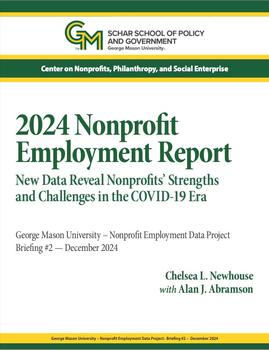In This Story

The nonprofit sector has long been a cornerstone of the U.S. economy, but the COVID-19 pandemic posed unprecedented challenges. A new report, the 2024 Nonprofit Employment Data Report, by George Mason University’s Nonprofit Employment Data Project (GMU-NED), sheds light on the sector’s recovery, resilience, and ongoing hurdles.
Compiled by the Center on Nonprofits, Philanthropy, and Social Enterprise at the Schar School of Policy and Government, the report offers an in-depth analysis of nonprofit employment and wages between 2018 and 2022. Drawing on data from the U.S. Bureau of Labor Statistics (BLS), the report compares nonprofit workforce trends to their for-profit counterparts during this pivotal period.
“Nonprofits play a vital role in our society, and this report demonstrates their resilience in the face of a global crisis,” said Schar School professor Alan Abramson, director of the center. But he cautioned that the report “also highlights areas where the sector continues to struggle to regain its footing, particularly in workforce recovery.”
The report highlights five key takeaways that explain how the nonprofit workforce has changed compared to other major industries.
- Third-largest employer: As of 2022, nonprofits employed 12.8 million workers, making the sector the third-largest employer in the U.S. nongovernment economy.
- Pandemic employment decline: Between 2019 and 2020, nonprofit employment fell by 580,000 workers—a 4.5 percent decline. However, nonprofits fared better than for-profits, which experienced a 7 percent workforce reduction.
- Slower restaffing: In 2021 and 2022, nonprofits lagged behind for-profits in workforce recovery. By the end of 2022, the nonprofit workforce remained 1.4 percent smaller than its 2019 level, whereas for-profits expanded by 2.2 percent.
- Decreasing market share: The nonprofit share of the total nongovernment workforce dipped from 10.2 percent in 2017 to 9.9 percent in 2022, reflecting losses across nearly all key nonprofit fields.
- Competitive wages: In 2022, nonprofit average annual wages were on par with for-profits and significantly higher in many critical fields where nonprofits are most active.
While nonprofits have regained nearly 70 percent of the workforce losses experienced in 2020, they remain behind their for-profit peers in returning to prepandemic employment levels.
“This data highlights the nonprofit sector’s dual identity as both resilient and vulnerable,” said Stefan Toepler, a professor of nonprofit studies and codirector of the GMU-NED project. “While nonprofit wages remain strong, staffing challenges pose a significant barrier to achieving full recovery.”
The report is a product of the GMU-NED project led by Abramson and Toepler and Schar School associate professor Mirae Kim, with contributions from GMU-NED Research Consultant Chelsea Newhouse, formerly of Johns Hopkins University’s Center for Civil Society Studies. This marks a continuation of the important work started by Johns Hopkins, with GMU-NED taking the helm to provide actionable insights for nonprofit leaders, policymakers, and stakeholders.
Looking ahead, the GMU-NED Project is preparing to launch the George Mason University Nonprofit Works Data Explorer, a cutting-edge tool that will empower users to access and analyze BLS nonprofit employment and wage data.
“We are committed to equipping the nonprofit community with the data and tools they need to thrive,” said Abramson.
The full report is available for download at this page. For more information on the GMU-NED Project and upcoming initiatives, visit GMU-NED Project.
